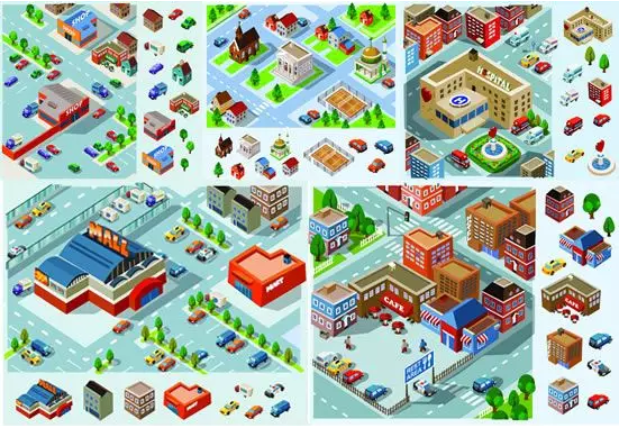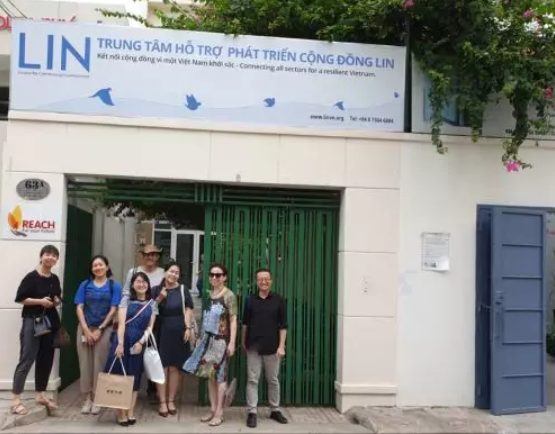5月28日—6月2日,正荣公益游学受社区基金会全球子基金(Global Fund for Community Foundations)的资助,学员们行走胡志明市,从不同的身份视角感受城市社区的发展。

这次我对社区基金会和社区慈善有了更进一步的认识。来自全球社区基金会基金的Jenny认为,社区基金会有两个最核心的功能。
This time I have got a deeper understanding of community foundations and community philanthropy. Jenny from the Global Fund for Community Foundations thought that there were two core features for community foundations.
第一,动员金钱,让金钱发挥更大的价值。在这一过程中,社区基金会不仅可以大方地吸纳社区外部的资金(例如来自其他基金会、政府的拨款等),还需要动员社区内部金钱参与到社区公共事务中来。
Firstly, funds mobilization, to make better use of the capital. When mobilizing funds, community foundations can not only generously absorb capital from outside the community (such as grants from other foundations and the government) but mobilize money within the community to contribute to the commons.
第二,组织调动社区内其他资源解决社区面临的问题,而且社区内部可调动的资源通常都比社区成员以为的更多。
Secondly, organizing mobilization of other local resources to solve local problems and generally speaking, there will be more resources within the community than what the community members expected.
在全球很多社区都遇到过这样的情况,当社区需要解决某个问题的时候,社区成员常常以为因为自己和本社区都相对贫困,这件事一定做不起来。但是最后通过动员和协调,却发现总会有人站出来跟其他人分享自己仅有的资源,而这样的人会越来越多,最终让资源得到有效流转。
Communities over the world have come across such a situation, that is, when they had to solve a certain problem in local, they used to think themselves and their community were relatively vulnerable so they could not solve the problem alone. But following mobilization and negotiations, they always found that someone was standing out to share with others his only resources, and there would be more and more people like him, and finally, resources were effectively shared and transferred.

在动员社区成员参与社区公共事务讨论和治理的过程中,社区基金会扮演着穿针引线、动员协调、资源分配的角色。
When mobilizing community members to participate in the discussions and governance of community public affairs, a community foundation may serve functions of going-between, mobilizing, coordinating, and allocating resources.
社区成员不仅可以更了解其他成员,也会对社区面临的问题有更清楚和宏观认识,同时在社区基金会的推动之下,共同参与社区治理,筹集资金和其他资源解决问题。社区的联系更加紧密、人们彼此间的信任也会进一步加强。
Community members can not only acquire a better understanding of other members but also clearer and more macro awareness of the problems faced by the community. At the same time, as driven by the community foundation, they can participate in community governance to raise funds and other resources for solving problems. Thus, connections within the community will be tighter and develop trust.
社区基金会作为扎根于社区的慈善组织,来自社区、服务于社区,如果不能解决社区的问题也就失去了自己存在的价值,会不可避免的失去社区成员的支持。因此,社区基金会天然地需要与社区成员更紧密地在一起,了解最新的社区需求的变化。
As a local philanthropic organization, the community foundation arisen from the community will in return serve the community. If they cannot solve the problem in their community, they will lose their value and inevitably lose the support of the community members. Therefore, community foundations naturally need to be more closely aligned with community members to understand the latest changes in community needs.
————————————————————————————————————————————————————————
作为一个通常以基金会形态存在的慈善组织,社区基金会在跟其他大型基金会、企业或国家财政对话的时候,具备更多话语权和天然优势。
As a charitable organization that usually exists in the form of a foundation, a community foundation has a saying and natural advantages when they talk to other large foundations, companies, or national finances.
一,更熟悉社区事务。因为地域、文化、人口、经济发展情况等各种原因,产生规模不一的各类社区。政府机构和外部基金会没办法准确了解到社区的需求。如果社区遇到难题,需要外部援助的时候,援助力量通常也一时无从下手。
Firstly, they are more familiar with community affairs. Different types of communities with different scales are formed due to various reasons such as geography, culture, population, and economic development. Government agencies and external foundations have no particular means to know the exact needs of the community. If a community faces troubles and needs external assistance, the aid force often has no idea where to start.
第二,从使命和运作方式上来看,以社区基金会为代表的社区慈善组织主要通过资金和资源的筹集运作,回应社区关切的问题。
Secondly, concerning the mission and operation, community charities presented by community foundations mainly respond to community concerns by raising funds and resources.
第三,基金会通过资助,连接着更多更细微的关键节点型个人或组织,可以将资源最高效和最迅速的分配。
有两个案例让我印象深刻。几年前,当尼泊尔遭受地震的时候,受灾面巨大。尼泊尔的一家社区型慈善组织妇女基金会TEWA,在灾害发生后迅速做出回应。一方面,TEWA跟自己的工作人员确认她们及家人的安全情况。同时,她们能够迅速通过过往积累起来的资助网络,把全国范围内遭受地震侵袭的社区情况快速统计出来。随着外部援助资金的到来,她们还是借着过往积累起来的资助网络,形成非常顺畅的横向的合作关系。捐款参与救灾的人数达到7000个人,其中竟然有2000名捐赠人来自受灾地区。
Two cases impressed me a lot. A few years ago, when Nepal suffered a large-scale earthquake. TEWA, a local women foundation in Nepal, responded quickly after the disaster. On the one hand, TEWA confirmed the safety of the staff and their families. On the other hand, they were able to quickly collect statistics in the earthquake-affected communities across the country by their accumulated funding network. Upon the arrival of external aid funds, they had formed a smooth horizontal partnership through such a network. The number of donors had reached 7,000, of which 2,000 were from the affected areas.

来自俄罗斯的Masha介绍了这样一个真实案例。在乌拉尔山深处的一个小村庄有一所小学。随着越来越多的人搬走,到这所学校上学的孩子数量减少。当地政府有意关闭这所学校。当地社区居民不希望关闭这所学校。他们于是自发发起了一个“漂亮学校”的工程,每个人尽自己所能,让这个学校变得更美。同时,他们还不断在媒体上提高人们对这所学校的关注程度。经过全村的努力,这所学校最后竟然变成了媒体上以及社会上知名度很高的一所学校,俄联邦政府还为此专门拨款支持学校的发展。也因为这所学校在媒体上的知名度,地方政府也就没有办法关闭这所学校。居民们才得以能够继续送他们的孩子到家附近的学校读书。
Masha from Russia introduced a case when there was an elementary school in a small and remote village in the Ural Mountains. As more and more people moved out, the number of children attending school reduced. The local government intended to close the school. But residents did not like the idea. They then spontaneously launched a campaign called “pretty school”, and everyone would do everything they could to make the school more beautiful. At the same time, they continued to call for awareness of the school by media. With the efforts of the whole village, the school became famous. The Government of the Russian Federation also made subsidies to support the school development. Because of its fame, the school stayed. The residents could continue to send their children to the school which was near their homes.
另外,跟我之前以为的不同,社区慈善其实是一个更大的概念。社区基金会虽然是一种较为常见的组织形式,但并非只有以“基金会”形式存在的机构才是社区基金会。在全球社区基金会基金遍布全球的200多个合作伙伴里,注册形式和名称可谓是五花八门。名字并不是社区慈善机构需要纠结的点。纵观全球,社区慈善组织有这样四个特点:
Besides, unlike what I thought before, community philanthropy is actually having a broader concept. Although community foundation is a relatively common form of organization, not only organizations that exist in the form of “foundations” are community foundations. The registration form and name can be diverse among over 200 members in the GFCF. The name is not the main point of community charities. Throughout the world, community charities have these four characteristics:
第一, 具备资产。社区慈善组织不仅在散财,还在社区内部培养给予的文化。
First, assets. Community charities not only donate money but also cultivate a giving culture within the community.
第二, 具备强大的中介的能力。社区慈善组织意在将更多的资金和各类资源统筹起来,支持社区的发展。他们筹资的目的,通常都不是为了让自身变得大、拥有更多员工,而是希望让更多资源能流动起来,流到社区中去。
Second, competitive ability in negotiating. Community charities are aimed at collecting more funds and resources to support community development. The purpose of their fund-raising is to make more resources flowing and allow them to be used in the community, instead of making themselves bigger with more employees.
第三, 建立信任和社会资本。社区慈善组织看重高质量的人际关系,重在让社区成员能互相喜欢,并且互相信任。他们在不同的机构里面、以及不同机构之间扮演穿针引线的角色。
Third, building trust and social capital. Community charities value high-quality relationships between people and focus on making community members like and trust each other. They act as a negotiator in the institutions and between different institutions.
第四, 不一样的权力关系。曾经,一提到地方,常常被人认为是不够的、欠缺的。当外部的资助方提供了很多援助的时候,受助人与资助人之间常常会形成不对等的权力关系,以资助人的意愿来办事。但是,社区慈善机构慢慢的改变人们的观点,认为社区里面是智慧的来源,社区中有各种各样的专长。这种权力的嬗变,不仅是南方与北方之间的变化,同时还要改变资助领域中一直以来的权力结构。

非常有趣的是,这次得以亲自体验越南当地一家支持社区慈善组织发展的机构的具体工作。LIN Center的年会主题始终是跨界合作,过去三年来每年一度的盛事都会吸引到全国各地的公益组织、大企业以及对外援助机构代表到场参与。很多人甚至从河内专程南下参加这个活动。2019年度是他们的第三次年会。本次年会时长1天,门票标价为75美元,这在越南当地属于很贵的活动。但即便如此,仍有约300人参会。而且参会人员几乎都全程参与。
It is interesting that I was able to explore the work of a local institution in Vietnam that supports the development of community philanthropy. The theme of LIN Center’s annual conference has always been transboundary cooperation. The annual events held in the past three years have attracted representatives from non-profit organizations, large enterprises, and foreign aid agencies across the country. Many people even traveled from Hanoi to take part in the event. This year’s meeting shall be their third annual meeting. And it had lasted for one day with a ticket price of $75, which may be expensive in Vietnam. But even so, about 300 people were attending the event, and most of them had stayed to the end.
Fourth, a different power structure. Once, when we mentioned the local, we often thought of insufficiency and shortage. When external funders offer much assistance, there is often inequity in the power relationship between the grantee and the funder, that is everything is carried out as donors wish. However, community charities are slowly changing people’s thoughts. They believe that the community is the source of wisdom because there are various skills in the community. This change in power is not only a change between the South and the North but also in the power structure of grant-making.

LIN Center,这家在越南开办相当久、在当地乃至全国都非常有名气的枢纽型公益组织始终通过能力建设、网络建设、小额资助、跨部门合作等形式支持越南当地各类公益组织的发展。在培力的过程当中,会针对不同规模、不同发展阶段的公益组织提供不同类型的支持。小到提供一场免费培训,大到分享办公空间、代为管理捐赠、协助注册等,LIN Center始终在为一线小微公益组织提供支持。也正是通过LIN Center的各种支持,才使得更多社区组织能在自己所在的社区,不管是残障人士、环保教育还是多元共融等领域,回应社区需求。
LIN Center is a nationally well-known pivotal non-profit organization that established in Vietnam long ago. It has been supporting the development of various local non-profit organizations in Vietnam through capacity building, network construction, making small grants, and cross-departmental cooperation. Different training supports will be specially provided for non-profit organizations of different scales and in the different development stages. LIN Center has always been supporting the local small non-profit organizations by offering free training, sharing office space, managing donations, and assisting them with registration. Thanks to the various support of the LIN Center, more community organizations can respond to the local community needs in the philanthropic fields such as helping the disabilities, environmental protection education or other diversified fields.